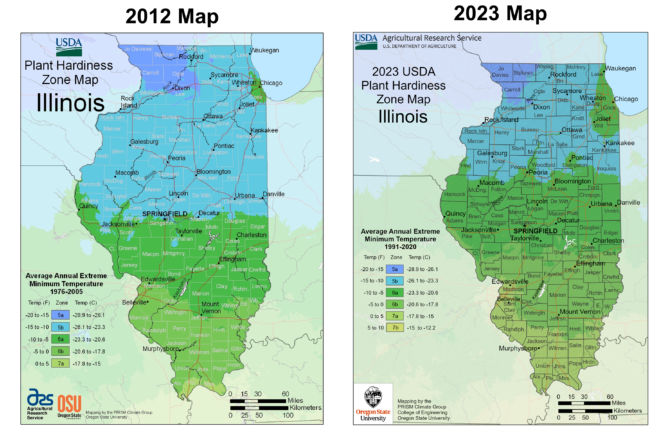Warming to the fact Illinois is movin’ on up!

Don’t you grow weary of every time there is some poll or study on state rankings that our good ol’ Land of Lincoln doesn’t usually fair well? But I am here to tell you today, at least on one list, we are moving on up:
We were a 5 and now we are a 6. The list I am talking about is an important one for gardeners and farmers alike, the USDA Plant Hardiness Zone Map.
The “coolest” thing about the new map that puts us in a warmer zone, is that you can go to this link: https://planthardiness.ars.usda.gov/ and enter your ZIP code and it will tell you the specifics. For any ZIP code in the United States. So where did this map come from, anyway?
The first map was created at Arnold Arboretum by Dr. Alfred Rehdeer in 1927 and based his findings on plant survivability in different regions of the country. In 1938, a new map was created, but this time using data from the National Weather Service from 1895 to 1935. The Arnold Arboretum map had updates in 1951, 1967 and 1971.
In 1970, the United States Department of Agriculture decided to create their own map, but used weather station data and different measures, so their map didn’t match up with the Arnold Arboretum which resulted in a great deal of confusion for the public.
But finally, in 1990, the USDA, working with the National Arboretum, created the USDA Plant Hardiness Zone map. The latest update prior to the one released just a few weeks ago on November 15, was in 2012.
As you can imagine, lots has happened in our world and with our weather since 2012. So back to my initial statement: We in Illinois are moving on up — all the way from Zone 5A, which previously has us with average minimum temperatures of -15 to -20 degrees to the balmy current Zone 6 which puts our average minimum temperature at -5 to -10.
Two questions arise right away: Why did this happen, and what does it mean for the people of the soil as I like to call us — the gardeners and the farmers? First the why is as confusing is as trying to get a straight answer from social media … almost impossible.
Before you start lecturing me that this is a political snowball, let me stop you right there. The “why” can be debated, but the “what” is real. They base these zones on actual weather data. So unless someone is trying to tinker with all the thermometers at all the official National Weather Service weather stations in the country, the fact is, we are warming up.
Now is usually the time people will, just as they do with drought, tell me that last week it was 19 degrees, and it was still November, so it is not warmer. With drought, I am amazed that every time we are in a dreadful, parched month-long drought, and we get a tiny 30-minute sprinkle, people call to ask me if I am glad the drought is over!
The hardiness zone is information on the average cold temperature. Sure, we will still have cold, frigid, pipe-breaking cold spells, but on average, it doesn’t get as cold for as long as it used to.
And nature tells us this all the time; we just don’t tie it to temperature change. I don’t know how many calls I have received the last two years asking what that bright yellow mid-spring flower that is blanketing everything. It is butterweed (Packera glabella), a winter annual.
But now ask yourself, prior to the last two years, did you ever see it here? Probably not. The same with the plant I call “living Velcro,” also known as Catchweed Bedstraw (Galium aparine). It is a late spring/early summer weed that has loop and hook attachments that literally Velcro to you.
Why do I bring these plants up? Because until about three years ago, we never saw them here. Why? It was too cold for them to take hold. And now? They are everywhere.
This doesn’t only apply to weeds/wildflowers though. Some of the plants that we love might not like the warmer weather. Think about our northern trees like maples. They are subject to environmental stressors, like … well all of our weather … but turning up the thermostat, and this hardiness zone doesn’t even cover the less moisture factor, and more maples may contract stress-related diseases.
And then there are the insect/insect relative pests. A sure sign of our geographical warming is the increased presence of ticks that were only known to inhabit the southernmost tip of Illinois; now frequently found up north. The bugs on the move applies not only to our home gardens but imagine how the agricultural community has to be on the lookout for pests that they have never had to deal with because it was too cold for them.
But is there are bright side? There is always a bright side to nature! Some of the tender perennials that we gardeners have had to treat as very expensive annuals or find space inside to overwinter; we may find the ones that were marginally hardy, now make it through winter.
Another possibly positive observation we witnessed this year, was how early our spring and summer plants started blooming. I had reports that some gardeners had coneflower blooming mid-June.
Keep in mind, though, that this map is about averages. Mother Nature will always love playing weather roulette with the Midwest.